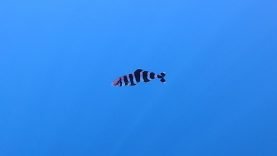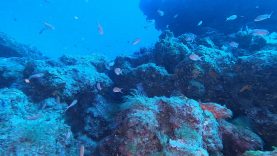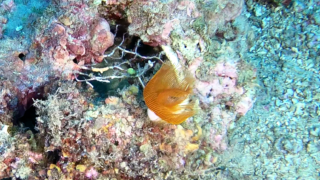White Sea Pen Pennatula bianca Pteroeides spinosum
Diving into the blue to make a nice dive, divers always hope to find the rocky bottoms that are usually the richest in life. Therefore, going to end up on a muddy, sandy bottom, or at best sandy, is almost never a good omen and it is always believed that the dive is lost. Penna di Mare Pennatula bianca Pteroeides spinosum intotheblue.it
Then, in addition to the muddy seabed, we find: turbid water, current, dark (practically no sunlight) and rough seas in formation, then the hopes definitely disappear.

So this dive seems to go badly, except for the encounter with the “White Sea Pen” White Pennatula Pteroeides spinosum, a rare soft coral of the Mediterranean Sea that belongs to the philum of the Cnidarians, to the class of Anthozoans, to the subclass of the Octocorals and to the order of the Pennatulaceai (Pennatulacea).

The images speak for themselves, the Sea Pen is about 30/35 cm high, and was found on a bottom of mud, debris and sand at about 52 meters deep. Unfortunately we did not stop there hoping to find other specimens as well, since they usually form small colonies, but it did not happen. The specimen was actually solitary and shared the desert sand and mud with other more common organisms such as sea urchins and starfish. However, it remains a beautiful meeting since even the IUCN classifies it as a rare and difficult species to meet: “The species is evaluated as Data Lacking (DD) because there is no recent data on the abundance and trend of the populations.”

The white pennatula belongs to the philum of the Cnidarians, to the class of the Antozoi, to the subclass of the Octocorals and to the order of the Pennatulaceai. The name cnidari justifies the presence of cnidocysts or rather stinging cells, distributed throughout the body and mostly in the tentacles.
The pinnatulaceae have a central skeletal axis built with spicules in which polyps thrive in oblique rows. A basal part of the skeleton is anchored to the substrate, mostly detrital or muddy. Observing the species of pinnatulaceae presents many difficulties for us divers as almost all pinnatulaceae love depths. Being able to find and photograph a white pennatula at night is certainly an adventure that remains etched in the booklet of our memories.
https://www.biologiamarina.org/pennatula

Distribution Species reported in the Ligurian, Tyrrhenian, Ionian, Upper and Middle Adriatic Seas. Also reported in the Messina Strait of Sicily.
Population It is not excluded that the species in the past was abundant on detrital bottoms exploited by fishing. A population with a density of 10col / m2 has recently been described in the southern part of the Strait of Messina, along the Sicilian coasts. Population trend Unknown
Habitat and Ecology Both solitary and in prairies. It usually lives on movable bottoms, especially with fine granulometry, below 30 m of depth. Also found in maerl and organogenic detritus. It reaches 30 cm in height. Limited mobility.
http://www.iucn.it/scheda.php?id=-808786686






















